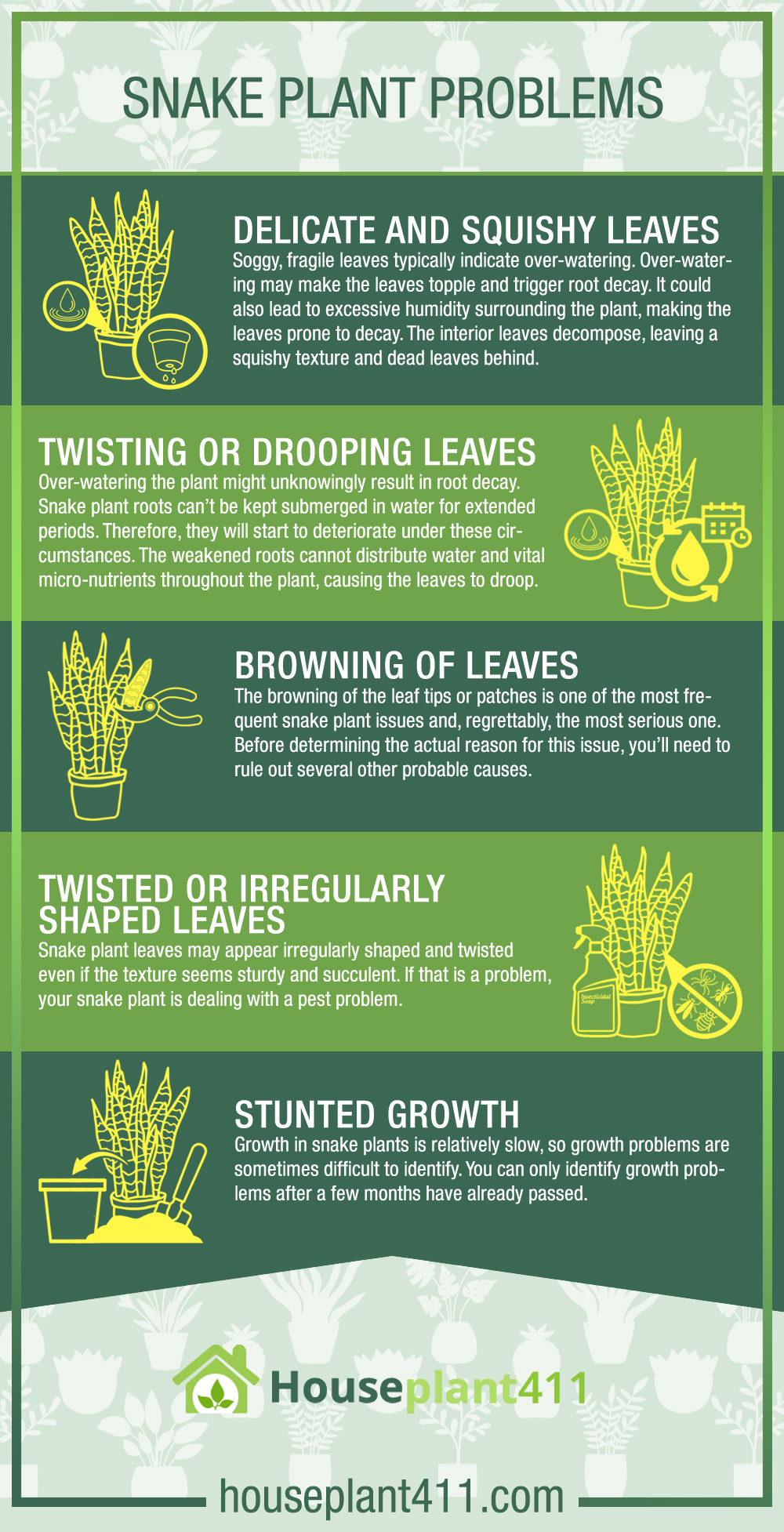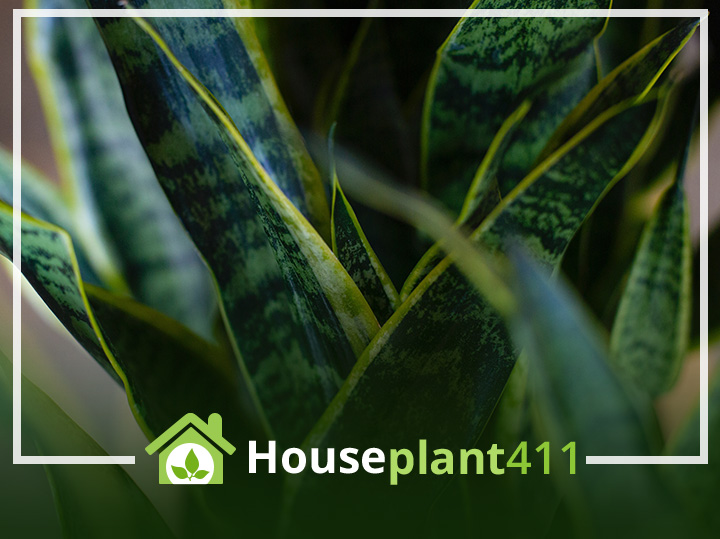Sansevierias, more commonly known as Snake Plants, are excellent indoor plants that purify the air by removing contaminants from the atmosphere. Although snake plants are resilient and simple to cultivate, growing them may still have difficulties.
Parents sometimes face difficulties, such as brown patches, root rot, wilting, or stunted growth, when cultivating or caring for a snake plant. Problems with snake plants can be addressed quickly with extra care and prompt corrective measures.
Here are some common problems with snake plants and how to fix them.
Delicate and Squishy Leaves
Sansevieria leaves are relatively thick and hard to the touch if they are in good condition. However, the leaves feel squishy and soft if the plant is not in good health.
Soggy, fragile leaves typically indicate over-watering. Over-watering may make the leaves topple and trigger root decay. It could also lead to excessive humidity surrounding the plant, making the leaves prone to decay. The interior leaves decompose, leaving a squishy texture and dead leaves behind.
If your container has insufficient drainage, it could also lead to mushy leaves, even if you’re watering it adequately. Houseplants, particularly those with succulent nature, like Sansevierias, require well-drained soil because they don’t dwell well in highly humid soil types.
In such situations, take the plant from its original container and plant it in newer, succulent-specific soil that drains properly. If you prefer, mix your own by combining potting soil with coarser soil to enhance drainage. Prune rotting roots and remove the diseased leaves to encourage new, healthy development.
Twisting or Drooping leaves
Sansevieria leaves have a sturdy upright look that’s aesthetically pleasing. What should you do if your once-proudly soaring foliage gradually begins to drop or bend?
Sagging or drooping leaves might indicate different issues, the most prevalent of which is over-watering.
The thick, water-storing foliage of snake plants has a succulent appearance. It makes them resistant to water deficiency. Because the leaves retain water, snake plants can survive for a few weeks without water.
Over-watering the plant might unknowingly result in root decay. Snake plant roots can’t be kept submerged in water for extended periods. Therefore, they will start to deteriorate under these circumstances. The weakened roots cannot distribute water and vital micro-nutrients throughout the plant, causing the leaves to droop.
It would be best if you changed the watering schedule to resolve this problem. These plants prefer being under-watered rather than over-watered. So, only water your snake plant after the topsoil looks completely dry.
If the roots look seriously harmed, trim off the affected sections carefully and repot the plant in fresh soil.
Transfer the snake plant to a spot with diffuse sunlight if it’s constantly exposed to the sweltering sun.
Browning of Leaves
The browning of the leaf tips or patches is one of the most frequent snake plant issues and, regrettably, the most serious one. Before determining the actual reason for this issue, you’ll need to rule out several other probable causes.
Physical harm is the immediate precursor of browning, which you can’t truly fix. The area of damage may turn brown when extreme weather or physical damage strikes the leaves of the snake plant. Sadly, nothing can be done to undo the damage, but it’s best to prune the damaged section to encourage the healthy development of new leaves.
The second reason for browning can be extreme weather conditions. Frost causes plants to freeze their cells, killing the plant when the cells defrost. The damaged spots will appear as brown blotches. Because the plant tissues die, they won’t be able to regenerate.
Similarly, scorching weather conditions can also lead to browning, which is more apparent on the tips. The tips of the snake plant’s leaves might scorch and become brown if overexposed to the sun.
If there is too much browning on the tips of the leaves, make sure you make alterations to the heat and watering requirements or check the fertilizer’s content.
Twisted or Irregularly Shaped Leaves
Snake plant leaves may appear irregularly shaped and twisted even if the texture seems sturdy and succulent. If that is a problem, your snake plant is dealing with a pest problem.
Seeing tiny insects like mites or thrips with your naked eye could be challenging. They typically go unnoticed until symptoms of harm start to appear. These insects eat the plant’s internal fluids as they sit on its foliage and in the subsoil. The leaves appear misshaped if not treated immediately.
Always be on the lookout for indicators of insect or disease threats when irrigating the plant. Infestations can be treated using natural DIY pesticides or gardening oil purchased online or from a nearby nursery.
Fungal diseases in snake plants are pretty difficult to treat. If the fungus has not progressed too much, it is best to prune the affected region and spray with fungicidal periodically.
If the spread of fungal disease gets out of control, isolate the plant or get rid of it to prevent the infection from spreading to neighboring plants.
Stunted Growth
Growth in snake plants is relatively slow, so growth problems are sometimes difficult to identify. You can only identify growth problems after a few months have already passed.
The first cause of stunted growth is the size of the pot. Most gardeners recommend repotting Snake plants every three to five years. Your plant can be pot-bound if dwelling in the same pot for several years. When repotting, choosing a pot 2-3 sizes bigger than the old pot is best to stimulate quicker growth.
The second most probable reason for poor growth is the absence of adequate sunlight. Plants undergo photosynthesis to grow, and photosynthesis requires adequate sunlight. In other words, the snake plant will only have the required energy for growth if it receives enough sunshine. Try moving it to a spot with more sun exposure, but ensure it’s filtered and indirect.
Furthermore, a deficiency of the soil’s nutrients can inhibit growth. When a plant in a container consumes all the soil nutrients, the barren soil cannot support the plant for growth. However, that doesn’t mean snake plants can survive in over-fertilized soil. It is best to provide the soil with well-balanced fertilizers periodically. Snake plants are among the most low-maintenance house plants when the conditions are right. If the plants aren’t doing well, modifying the growing conditions can help.


